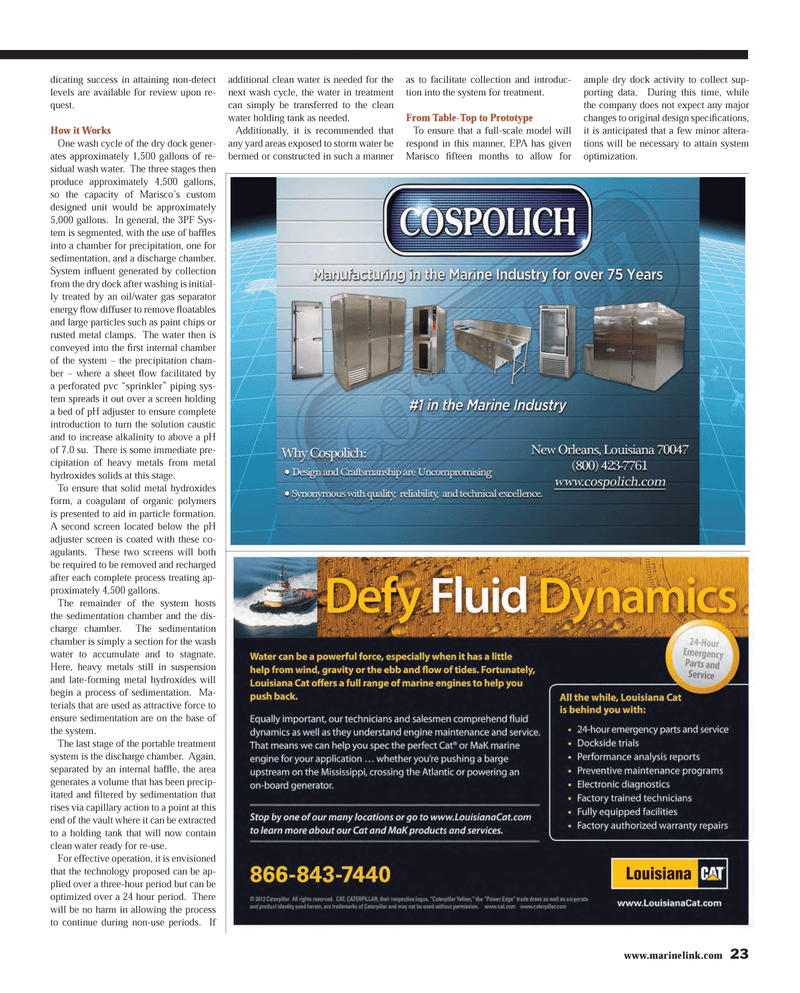
Page 23: of Maritime Reporter Magazine (July 2013)
Maritime Security Edition
Read this page in Pdf, Flash or Html5 edition of July 2013 Maritime Reporter Magazine
www.marinelink.com 23dicating success in attaining non-detect levels are available for review upon re-quest.How it Works One wash cycle of the dry dock gener- ates approximately 1,500 gallons of re-sidual wash water. The three stages then produce approximately 4,500 gallons, so the capacity of Marisco?s custom designed unit would be approximately 5,000 gallons. In general, the 3PF Sys-tem is segmented, with the use of bafß es into a chamber for precipitation, one for sedimentation, and a discharge chamber. System inß uent generated by collection from the dry dock after washing is initial-ly treated by an oil/water gas separator energy ß ow diffuser to remove ß oatables and large particles such as paint chips or rusted metal clamps. The water then is conveyed into the Þ rst internal chamber of the system ? the precipitation cham-ber ? where a sheet ß ow facilitated by a perforated pvc ?sprinkler? piping sys-tem spreads it out over a screen holding a bed of pH adjuster to ensure complete introduction to turn the solution caustic and to increase alkalinity to above a pH of 7.0 su. There is some immediate pre- cipitation of heavy metals from metal hydroxides solids at this stage.To ensure that solid metal hydroxides form, a coagulant of organic polymers is presented to aid in particle formation. A second screen located below the pH adjuster screen is coated with these co-agulants. These two screens will both be required to be removed and recharged after each complete process treating ap-proximately 4,500 gallons.The remainder of the system hosts the sedimentation chamber and the dis-charge chamber. The sedimentation chamber is simply a section for the wash water to accumulate and to stagnate. Here, heavy metals still in suspension and late-forming metal hydroxides will begin a process of sedimentation. Ma-terials that are used as attractive force to ensure sedimentation are on the base of the system.The last stage of the portable treatment system is the discharge chamber. Again, separated by an internal bafß e, the area generates a volume that has been precip-itated and Þ ltered by sedimentation that rises via capillary action to a point at this end of the vault where it can be extracted to a holding tank that will now contain clean water ready for re-use.For effective operation, it is envisioned that the technology proposed can be ap-plied over a three-hour period but can be optimized over a 24 hour period. There will be no harm in allowing the process to continue during non-use periods. If additional clean water is needed for the next wash cycle, the water in treatment can simply be transferred to the clean water holding tank as needed.Additionally, it is recommended that any yard areas exposed to storm water be bermed or constructed in such a manner as to facilitate collection and introduc-tion into the system for treatment.From Table-Top to Prototype To ensure that a full-scale model will respond in this manner, EPA has given Marisco Þ fteen months to allow for ample dry dock activity to collect sup-porting data. During this time, while the company does not expect any major changes to original design speciÞ cations, it is anticipated that a few minor altera-tions will be necessary to attain system optimization.MR #7 (18-25).indd 23MR #7 (18-25).indd 237/1/2013 9:14:40 AM7/1/2013 9:14:40 AM

 22
22

 24
24
